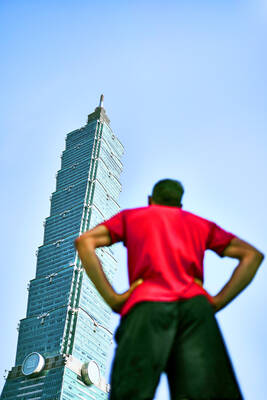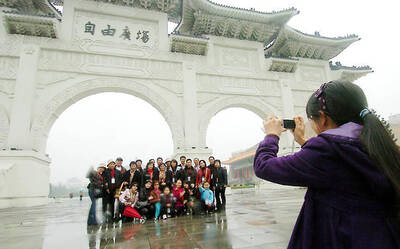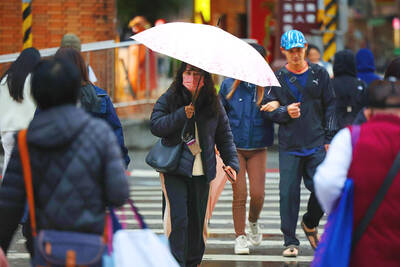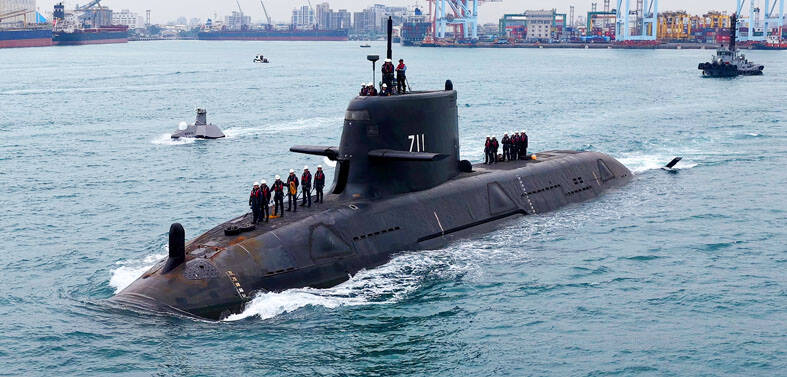On the 71st anniversary of the end of World War II in Asia yesterday, pro-localization groups again urged the government to establish a memorial park and a monument to commemorate the Taiwanese who died in the Japanese campaign, a history that they said was deliberately neglected by the Chinese Nationalist Party (KMT) regime.
Advocates and academics said the memorial park and monument should be built to counter the historical narrative imposed by the KMT regime that stressed the Republic of China’s role in the Second Sino-Japanese War, while the forgotten history of Taiwan in World War II involved Taiwanese conscripts fighting for Japan across Asia and the Pacific, as well as Allied air raids on Taiwan.
According to the Japanese Ministry of Health, Labor and Welfare, a total of 207,183 Taiwanese served in the military of Imperial Japan either as soldiers or in noncombat capacities, of whom 30,300 were killed in action and more than 20,000 were missing in action.
“The number of Taiwanese war dead was more than those persecuted in the 228 Incident, but there has been no memorial service in Taiwan to commemorate wartime victims,” Aletheia University professor Chen Li-fu (陳俐甫) said.
“Some Taiwanese have been criticized for paying tribute to Taiwanese war dead enshrined in the Yasukuni Shrine in Japan, but there is no monument to commemorate them in Taiwan,” Chen said.
Taiwan’s wartime history was neglected and distorted to serve the KMT regime’s China-centric narratives, and the nation has yet to face its wartime history to bring about transitional justice and reconciliation, Taiwan Association of University Professors chairman Peter Chang (張信堂) said.
“It was not until last year, when the association held an exhibition about US air raids on Taiwan during World War II, that many Taiwanese realized Taiwan was ever bombed by the Allies. They came to understand that their history was dramatically different from what was taught in schools,” Chang said.
Taiwanese have been taught history that is not closely relevant to Taiwan, and few people know that more than 20,000 Taiwanese are enshrined in the Yasukuni Shrine, National Chengchi University history professor Hsueh Hua-yuan (薛化元) said.
Taiwan Tower, a monument to remember Taiwanese servicemen fighting for Japan, was unveiled in Japan’s Okinawa Prefecture in June, and there is a similar monument in the Philippines, but Taiwan does not have its own memorial park and monuments to remember that history, they said.
While countries remember World War II with a variety of ceremonies and works of art, Taiwan is oblivious to its wartime past, New Power Party Legislator Freddy Lim (林昶佐) said.
Taiwan suffered great losses during the war, as more than 3,000 civilians were killed in the Taipei Air Raid on May 31, 1945, Lim said, adding that 173 Taiwanese were convicted as war criminals.
“Taiwan does not have any national-level memorial for its wartime history. Even now, attempts to address Taiwan’s wartime history will be stigmatized. However, it is time that we remember that history,” Lim said.
A monument could be built on the green plot in front of the Huashan 1914 Creative Park in Taipei, which used to be a train station and a military factory during the Japanese colonial era, he said.

US climber Alex Honnold is to attempt to scale Taipei 101 without a rope and harness in a live Netflix special on Jan. 24, the streaming platform announced on Wednesday. Accounting for the time difference, the two-hour broadcast of Honnold’s climb, called Skyscraper Live, is to air on Jan. 23 in the US, Netflix said in a statement. Honnold, 40, was the first person ever to free solo climb the 900m El Capitan rock formation in Yosemite National Park — a feat that was recorded and later made into the 2018 documentary film Free Solo. Netflix previewed Skyscraper Live in October, after videos

NUMBERS IMBALANCE: More than 4 million Taiwanese have visited China this year, while only about half a million Chinese have visited here Beijing has yet to respond to Taiwan’s requests for negotiation over matters related to the recovery of cross-strait tourism, the Tourism Administration said yesterday. Taiwan’s tourism authority issued the statement after Chinese-language daily the China Times reported yesterday that the government’s policy of banning group tours to China does not stop Taiwanese from visiting the country. As of October, more than 4.2 million had traveled to China this year, exceeding last year. Beijing estimated the number of Taiwanese tourists in China could reach 4.5 million this year. By contrast, only 500,000 Chinese tourists are expected in Taiwan, the report said. The report

Temperatures are forecast to drop steadily as a continental cold air mass moves across Taiwan, with some areas also likely to see heavy rainfall, the Central Weather Administration (CWA) said. From today through early tomorrow, a cold air mass would keep temperatures low across central and northern Taiwan, and the eastern half of Taiwan proper, with isolated brief showers forecast along Keelung’s north coast, Taipei and New Taipei City’s mountainous areas and eastern Taiwan, it said. Lows of 11°C to 15°C are forecast in central and northern Taiwan, Yilan County, and the outlying Kinmen and Lienchiang (Matsu) counties, and 14°C to 17°C

STEERING FAILURE: The first boat of its class is experiencing teething issues as it readies for acceptance by the navy, according to a recent story about rudder failure The Hai Kun (海鯤), the nation’s first locally built submarine, allegedly suffered a total failure of stern hydraulic systems during the second round of sea acceptance trials on June 26, and sailors were forced to manually operate the X-rudder to turn the submarine and return to port, news Web site Mirror Daily reported yesterday. The report said that tugboats following the Hai Kun assisted the submarine in avoiding collisions with other ships due to the X-rudder malfunctioning. At the time of the report, the submarine had completed its trials and was scheduled to begin diving and surfacing tests in shallow areas. The X-rudder,